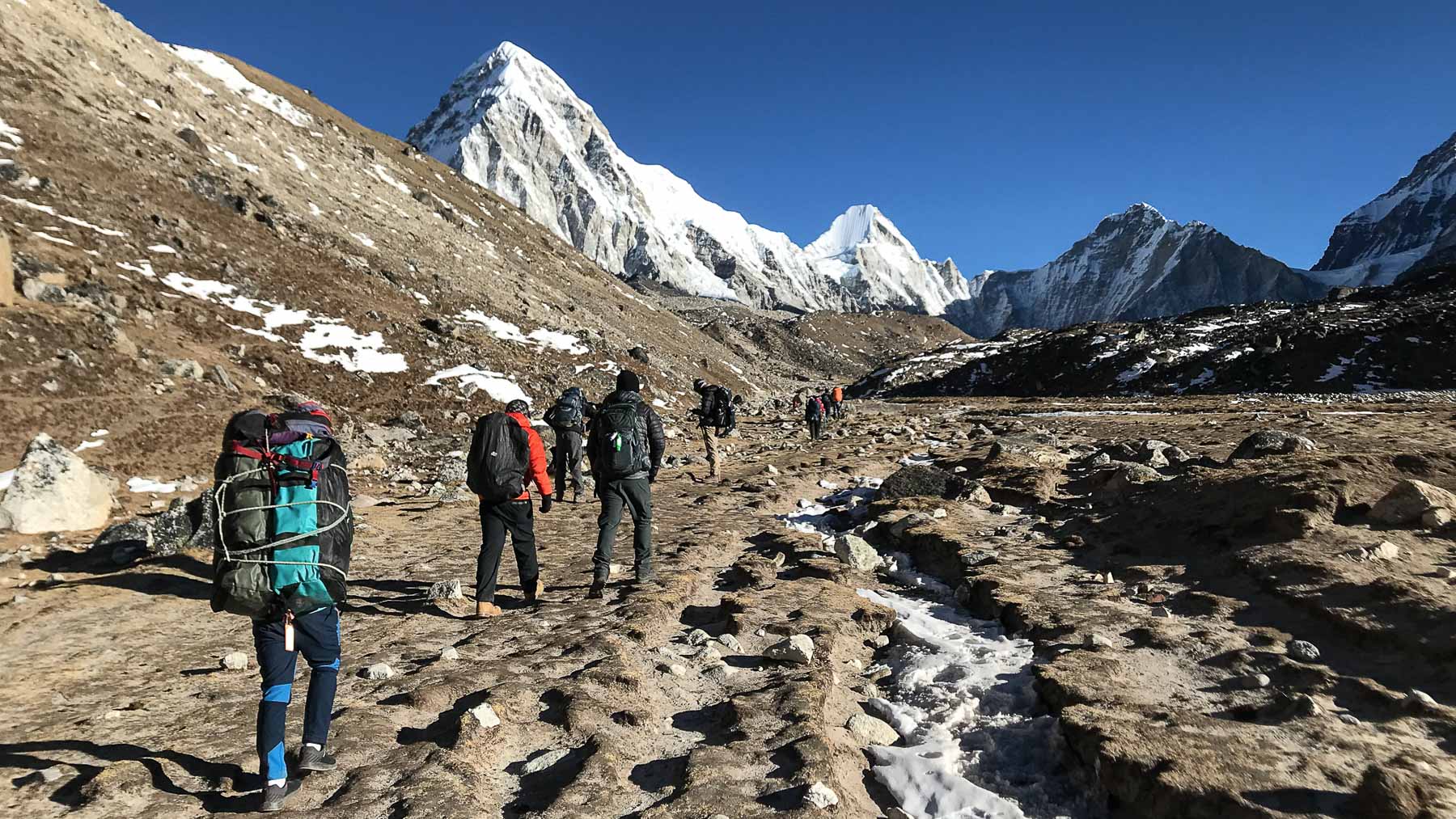What Makes the Everest Base Camp Trek Special?
Indeed, the Everest Base Camp trek is not merely a hike – it is so much more: the route embraces natural grandeur, cultural heritage and most of all, an adventure itself! Situated in The Great Himalayas Hemis National Park, this trekking spot has eye-soothing views of The World’s Highest Mountain – Mount Everest on one side, while remaining delight is that of leading chain of peaks in the world. Snow-capped mountains, lush valleys and shimmering glacial lakes embrace trekkers at every turn with a visual brilliance that uplifts the soul and leaves one in awe.
But the hike is about more than just the stunning scenery. Native to this harsh landscape, it has a long and storied history in the wider Sherpa culture. The trail binds together scenes of vibrant villages, ancient monasteries and intricately carved Chortens that seem to embody the spiritual soul of the place. Trekking through local communities gives you an opportunity to learn everything about life of Sherpa people, their rituals, habits and how closely connected with the mountains are they. This cultural immersion helps to improve the trekking experience by adding as sense of history and what it was like in this wonderous expanse shaped by culture.
This physical component of the journey gives even further weight to their travels. Canvasing through different terrains from dense forests to hilly terrain, Trekkers hit their own saturation point and leverage the resilience that they may not even have known that it existed. The trek to Everest Base Camp is known as a journey of perseverance and overcoming, which ultimately promotes self- development and understanding. The other hikers with whom you bond turn the adversity into a shared experience, bathed in camaraderie that comes out in exuberance laughter, and support; forever friends formed.
Furthermore, the trip finishes at Everest Base Camp — a destination with great history and fantasies associated to it. One of the jewels in Nepal’s tourism crown, trekkers stand at the base of the world’s tallest peak with a dusting of snow on its tip, succeeding where many others have made this journey before. Nearer the cave entrance, climbers are gearing up for their ascents, a wonderful touch lending dreams of exploration and adventure.
Although the trek to Everest Base Camp is extraordinary for its stunning landscapes and cultural experiences, it also makes you feel like a different person. There is a method behind every stride, giving the journey more depth then something you can just walkaway from once it ends. And by the end of the trail, whether we truly understand why or not, its message is clear: it is a testimony to nature’s beauty and humanity itself and the belief that no matter how new heights seem unattainable, there will always come further inspirations.
Everest Base Camp Trek Overview
True to its name, The Everest Base Camp trek is one of the iconic walking on the mountain journey, grabbed by nature and adventure lover around the world. Located in the heart of the Khumbu region of Nepal, this trek combines stunning views with a deep cultural experience and physical challenge. The trip usually lasts 12 to 14 days during which trekkers traverse beautiful villages, dense forests and high altitudes to reach the base camp of world’s highest peak, Mount Everest. The trek starts in Lukla, where travelers make the short flight to the small airport before they follow a nice, well-marked trail through the spectacular Himalaya.
It is not the end which makes this trek so special but the journey itself. Trek across remote passes with the backdrop of the Himalaya as you pass through local Sherpa communities, ancient monasteries, and diverse ecosystems that transform dramatically as altitude increases. Every day reflects new scenery, sounds, smells & sensations and a strong relationship with both the surroundings as well as the surrounding socio-cultural milieu is formed. The trekking in the Everest Base Camp trek go beyond just a physical experience: it is about self-discovery, adventure and contemplating the divine beauty of the Himalayas.
Stunning Himalayan Landscapes
The Everest Base Camp trek has some of the most beautiful scenery in the world. The trek provides fabulous views of Mount Everest, Lhotse, Nuptse and several other peaks along with the exploration of the Khumbu region. A dramatic, topography adds towering cliffs, deep valleys and massive glaciers as awe-inspiring scenery that changes around every turn of the trail. The trek that starts from lower altitude where hills are green and extends till high-altitude terrain where it changes to rugged beauty is a visual treat for the lovers of nature.
As trekkers pass by picturesque valleys filled with traditional Sherpa villages and prayer flags fluttering in the breeze, the landscape comes alive not only in terms of height but also vibrance. The adventure also will take you to other majestic lakes formed with the melting water of the glaciers and rivers reflecting colors from multiple shades of blue and gray, fantastic for excellent photos. Every sunrise brings new panoramas that amaze us and that keep it a thrilling experience in every step we make into the trail. Whether it is Crest of the light and shade on the mountains, or early morning sunlight laying its hand on them, these golden hours make few moments in trekkers life that are never to fade out. This captivating trek up to the Everest base camp is an unforgettable journey giving you a chance to observe some of the most beautiful landscapes and scenarios in Himalayas which are hard to define through wires.
Overcoming high altitudes
One of the biggest things is the high altitude.. which Short Everest Base Camp trek throws at you. The trekkers reach altitudes greater than 5,000 meters (16,404 feet), where the air is thin and oxygen levels are reduced resulting in diverse physiological challenges. If the thought of making this journey intimidates you, you need to be aware of altitude sickness. Your symptoms may be as mild as a headache or you may develop full blown mountain sickness that necessitates emergency descent. To ensure that trekkers do not fall victim to these conditions, they are normally provided with an itinerary that sufficiently spaces their ascent to allow their bodies ample time for acclimatization.
During the trek, you will cross different terrains — grassy forests and moss-covered rocks to barren lands and ice fields; all of which provide contrasting trials for your body and your mind. Long days on the trail, high altitude and daily treks can take its toll. But, quite a few trekkers might consider working through these struggles as they are learning and going through something valuable.toolStripSeparator This is the essence of it — developing mental strength and willpower, because they have to learn how to push through the pain and sleepiness.
The most challenging element of high altitude treks is the preparation. Physical preparation, hydration and body awareness are just part of the equation. If one is prepared properly and has proper mindset, trekking in high altitude becomes rewarding.
Traditional Culture and Rich Sherpa Customs
In addition to taking you through some of the most breathtaking landscapes, the Everest Base Camp trek also offers the cultural immersion by giving you insight into traditional Sherpa culture. With a rich mountaineering legacy and cultural roots centered around the top of the world, the Sherpas have crafted their way directly into this trek. While moving through delightful urban communities like Namche Bazaar trekkers have welcomed via inviting local people who frequently share anecdotes about their days, conventions and the otherworldly significance of the mountains.
The trek passes through many ancient monasteries and stupas, such as the Tengboche Monastery that offers a vibrant opportunity to observe rituals and in learning about Buddhism, the main religion of the land. Everything around is decorated with colorful prayer flags representing peace, compassion and wisdom which just indicates the spirituality of Sherpa people. By getting involved in local practices, for example partaking in traditional festivals or tasting local foods, trekkers might experience actual Sherpa culture.
Thus, this cultural immersion gives more gravitas to the trek experience because it allows a nod of respect and understanding from one side (trekker) towards an other but counterpart — the local community. Instead, trekkers come to a greater level of respect for the journey by appreciating the rich traditions and way of life of the Sherpa people, thus making it so that an already adventurous opportunity turns into experiencing a culture as well.
Diverse Flora and Fauna
The trek to the Everest Base Camp itself is home to some of the most diverse flora and fauna, as it is located in a high altitude region which supports various types of ecosystems. A homage to more than a natural wonder, as trekkers ascend, they are transported through the climes and their lifeforms. The lowland regions are draped in dense forests of rhododendron, fir and pine trees, splashing the terrain with bold hues of color especially during spring season full bloom of Rhododendron flowers. These forests also provide home to a lot of wildlife including monkeys, deer and many bird species that create a cacophony and give life to the trek.
The vegetation changes dramatically with the rise in elevation, replaced by alpine shrubs and sturdy grasses. As rugged as these environments become, you never really leave life behind at high altitudes. Wildlife enthusiasts and photographers can spot the rare species here like elusive snow leopards, Himalayan tahr inhabiting at the higher altitudes.
It boasts breathtaking biodiversity which is important to maintain ecological equilibrium. It is a stark reminder to trekkers how conservation efforts are critical in the preservation of these fragile environments. Seeing the different flowers and animals that can be found along the trail adds an extra element to each hike: you feel much closer to nature, and more appreciative of what a wonderful array of strategies creatures have evolved in order to survive whatever nature throws at them. The beauty of the natural Everest region helps remind us of how amazing this planet is, and the opportunity we have to preserve it for future generations.
Significance in History of the Route
It is not just a physical journey; it is every bit pilgrimage in mountaineering history. The Everest base camp trek here that undoubtedly designed for an encounter with the rich past heritage. Legends of climbing the route include Sir Edmund Hillary and Tenzing Norgay, who were first to reach Mount Everest’s summit in 1953. Their trailblazing, landmark feats are highlighted across the trail to commemorate their bold dreams that led them on this journey. Historical checkpoints (and Mike tells me the various memorials to climbers who have died trying) become haunting echoes of their barriers in such a severe environment.
The route to Everest Base Camp is a melting pot of culture as well, where Sherpa people have adopted the traditions and norms that flow through their veins from generations. Their history with the mountain makes it that much more special to hike. Stone houses, prayer wheels: echo of stories that weave tales of resilience and worship for the mountains with every step trekkers take through ancient villages. For good or bad, the route speaks volumes of human initiative and interaction with natural elements while offering a literal time portal forward with every step.
Marvel at the Sunrises and Sunsets
One of the most beautiful things you will find on your trek to Everest Base Camp is a breathtaking sunrise or sunset that turns mountains sheep colors. On most mornings, trekkers start their day in the wee hours of the morning to see Mt. The sun teeters behind the mother of all peaks in an attempt to lock it into place, throwing golden rays across the white capped summits of Everest (8,888m), Lhotse (8,516m) and Nuptse (7,861m), which makes for a breathtaking view that never fails to stun any trekker into silence. In the early light, the mountains turn pink and orange against a deep blue sky.
Alternatively, the Himalayas offer a kaleidoscope of colors during a sunset as the sun sets in the Tallest mountains on Earth. As the light fades, deep valleys cast still longer shadows over the mountains, a serene and reflective calm overwhelms my soul. Kalapatthar is a popular spot, which offers stunning all-pervasive views allowing us to freeze these magical moments in time. This is a moment of great emotion for many trekkers as they take time to offer gratitude for their own journey, the beauty around them. Those beautiful memories float up as so much mist and are left behind like the fleeting sunrises and sunsets that climb over those mountains before returning to shadows, but ephemeral beauty serves as a reminder of life in all its splendor.
Working With Communities Where We Live
Interacting with local communities is a big part of the Everest Base Camp trek Hike and it enriches the experience. While trudging on the tracks, trekkers cross over lovely Sherpa towns ready to extend warm cordiality. This meeting provides the invaluable chance to learn of the Sherpa way of life, their customs and ancient ties with the mountains. Guests are frequently welcomed into the homes and teahouses for stories, traditional meals revealing glimpses of daily life in this region.
The trek also offers an opportunity to be a part of local festivals and rituals, offering an insight into the Sherpa culture. Trekkers can also watch the colorful festivals like Dashain or Mani Rimdu to explore spiritual practices and togetherness among community. It provides you with an insight into the culture of the people you interact with and helps foster a system of mutual respect and understanding between trekkers, as well as locals.
It helps the trekker gain a new, or enhance an already existing appreciation of the lands she traverses; how the delicate balance between fun and profit can so easily be disturbed. These exchanges frequently establish connections that continue well past the trek and sometimes become what often are life-long friendships, a foundation stone for truly unforgettable memories that renders it not only an adventure but journey of connection.
Achievement and Personal Growth
It actually creates quite an incredible amount of self-satisfaction knowing you have trekked through there! Trekking across rough terrains, going through different climates, and up to even altitudes to test their endurance. The sheer remoteness of the Chinese side of Everest adding an extra layer to what is already a huge physical and mental challenge with each footstep on the way up to the iconic base camp. All tough-love not-withstanding, even the trekkers face obstacles on their journeys, and typically beating these obstacles gives them a sense of achievement that adds to their self esteem, persistence.
The trek also sets the perfect ambiance for inner soul searching. In between, the trekkers gets lot of peace moments Millions and zillions of thoughts seep through one experience chronicles sitting in lap of hauntingly beautiful landscapes and Himalayas and surely clouds well beyond their reading times…. The physical theatre regularly inspire Your Way actors to leave their comfort zones behind for the week, in turn giving way to incredibly poignant realisations surrounding ability and desire.
Everest Base Camp is not just a destination it represents the last stage of struggle, endurance and self development. What the journey does do is change us for the better, changing perspective, reminding of who we were before, and what it took to leave home. With trekkers taking these often lifelong lessons from the Home of Adventure back home, after all, it is this sense of accomplishment in life that thrills them and makes them feel more alive.
Unique Teahouse Experience
You get that neat little personal touch by being able to experience a teahouse on the Everest Base Camp trek. Teahouse treks are unique because they provide an opportunity for trekkers to experience local culture with simple comforts instead of camping the traditional way. With their characteristic wooden exteriors and sweeping eaves, these endearing teahouses administered by Sherpa families offer a homey location for trekkers to relax, interact, and relate tales of their adventures. They have local art, photographs and artifacts that reflect the rich culture of the region.
Food in the teahouses is also a highlight, showing Sherpa dishes. While legions of mountaineers can delight in dal bhat, a well-being powerhouse of rice and lentils, matched with delicious veggie curries and also cozy bread. Breaking bread with your fellow trekkers and local hosts helps build a tight-knit community, where you can swap stories and compare experiences.
In addition, it is where cultural traditions are learned (for example the fascinating lore of the Sherpa culture) and can be shared, as teahouses sometimes act as a meeting point for trekkers seeking an authentic ‘exchange’. While the trek is an increased level of intensity, the teahouse experience thrives unique comfort and connection which only enriches our understanding or appreciation for life locally. Teahouses are essential to this and, as trekkers discuss the routes and experiences with one another, end up becoming more than just places to rest — they become an active part of the adventure, resulting in affectionate memories that will remain long after returning home.
The Spiritual Link of Mt. Everest
It’s not always about being physically challenged, but it is also the spiritual journey that most of the trekkers acquire while trekking to Everest Base Camp. The Sherpa people call it Chomolungma, while adventurers refer to it as Mount Everest Trekking. To the Sherpas, it is a deity, a living entity that is their source of heritage and divine union with the celestial bodies. The trekkers literally walk through this spiritual field as they travel through the Khumbu region and the awe-inspiring peaks, where for most a sense of worship and soulful reflection occurs.
Over the course of the trek there are plenty of moments on this gruelling adventure that beg one to question their own destiny; what and where we want to be, our higher callings and all things organic. Himalayas in particular often inspire feelings of humility and connection to the world. Rituals of stopping at stupas and monasteries facilitate the larger themes of reflection -meditations and prayers, this spiritual connection becomes romanticized. It becomes a heart and soul experience where trekkers let go off the burnouts of their daily lives and get to surrender in peace amidst the beauty & grandeur offered by these mountains. This spiritual element of the trek adds to its attraction, tying right into every-day-life as a transformative experience that stays on long after getting home.
Photography Opportunities
The Everest Base Camp trail has the making of a photographers paradise, Brimming with landscapes and moments that scream for capture. One is met straight away with wide panoramas of verdant valleys, glittering glaciers and, invariably, those classic shapes that rise out of the ground like nails hammered into a wooden board. In addition to this experience of light pushing its way over the world, it illustrates the beauty around me because each change in light quality during the day gives golden landscapes of pinks and purple mountains — a photographer’s dream for sunsets.
Parties bound for Everest Base Camp use key sites along the trail — Namche Bazaar, Tengboche Monastery and Kalapatthar – as perfect backdrops to frame their efforts in pursuit of mighty Himalayan glory. Captured through the lenses, you get to witness more than just breathtaking landscapes but the vibrant local Sherpa culture—from the waving prayer flags to native architecture intricacies.
The experience also creates the opportunities for other candid images, moments of laughter, struggle and accomplishment that the trekkers share, something that is lost in scenery. There are so many different things that you will have the chance to take photos of, this gives you lasting memories that can help you remember, and share your everest base camp trek knowledge, capturing all the magic and spirt of the journey in pictures.
Variety of Trekking Routes
A major benefit of the Everest Base Camp trek is that there are a number of different trails you can take depending on what sort of experience you are looking for and your ability. This is the traditional route via Namche Bazaar which it would be rude to avoid because it’s popular, successful brings great views and cultural interaction. The trek starts with you getting know the vibrant Sherpa culture, allowing yourself to acclimatize gently as you go further up.
For those who want a photographic alternative, the Gokyo Lakes trek offers trekkers with an exciting experience through pristine glacial lakes and high altitude mountain passes. It is a short route to the Everest Base Camp, with excellent thoughts of Cho Oyu and brilliant dusty blue lakes.
As the name suggests; for those who want to take on the challenge of high passes like Kongma La, Renjo La, and Cho La which adds to the adventure and present various different landscapes, then guy’s you are in it for a bomb three passes trek trip. The traditional Jiri to Everest Base Camp route, meanwhile, provides an opportunity to experience the region in a more nourishing way with fewer tourists around.
The individual routes offer different challenges and rewards, meaning hikers can customize their hike according to their fitness level or areas of interest. This variety ensures each trip to Everest Base Camp is different, meeting the needs of any trekker looking for adventure, cultural experience or scenery.
Support from Fellow Trekkers
The trek to the Everest Base Camp is no a solo adventure; it is an experience shared in groups where trekkers never travel alone and provide each other with mutual companionship and assistance. When people of all walks of life join together to experience the trail, it makes for exemplary human experience. High altitude, physical exertion, and unpredictable weather are challenges nobly borne by all trekkers in common, turning strangers into friends laughing or calling out words of encouragement and support as we make our way up the trail.
When fighting against hard stages of the trek, many times, fellow trekkers give a hand or say something to lift your spirits or make you feel like they are right there to hear you out. This camaraderie builds a type of toughness that helps see us through pain and tiredness. And, of course, celebrating milestones like scenic viewpoints or teahouses is even more fun when done together.
Additionally it also connects trekkers on a different level, and fosters better relation post the trek. The supportive environment allows for growth as people feed off one another and push each other out of their comfort zones. In the end, it is all collapsing under the camaraderie of other trekkers along the route to Everest Base Camp, converting his endeavor into a collective effort that sets life-long reminiscences and close companions.
The Journey of a Lifetime
The journey of a lifetime, the Everest Base Camp trek, is an experience that combines several experiences. A melting pot of stunning scenery, cultural interactions and mental trials that hit home with trekkers everywhere. This trek provides a special chance to strike an unspoiled commune with the unparalleled beauty of mother nature leaving you gobsmacked in awe and respect for the magnanimity of the Himalayas.
In addition, the relationships with local people and insights in life as a Sherpa are what bring much depth to this epic journey. The demand of the trek on the body causes a range of emotions and thinking time which ultimately gives each person who treks this, an opportunity to push through their boundaries and find some strength that was previously unknown.
Not only the spiritual connection with the mountains that takes place, a brotherhood is formed amongst trekkers which increase their overall trekking experience and whom they remember lifelong. From watching the sun rise over Everest to eating a meal in a teahouse with locals, all of it forms an amazing masterpiece of memories.
In the end, Everest Base Camp trek is not just a journey to complete; this is a path to transformation that touches the soul of an individual. This is a journey that elicits such an awe for the beauty of nature, the culture diversity and faith in humanity which truly defines it as One Journey Of Life Time.
Read More: Craze Radar!






